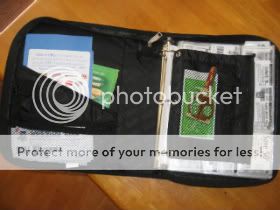I'd never really focused much on using coupons until recently. Before I would always have the coupons in an envelope or folder and sift through them through the store. Sometimes I'd find a usable one, but most times they'd expired long before I pulled them out.
So, when I decided to get serious about clipping coupons I decided I needed a better way to organize them. I went on e-bay and looked up coupon organizers, and found a style that I thought would work well for me. Then I went to my local office supply store and bought everything I needed to make my own for about $20
less than I'd have spent on e-bay. Now every week I bring my little binder with me, set it in the little compartment in the cart, open it up and leaf through it as I shop. When I find a coupon, I pull it out and stick it in a designated spot.
Start by purchasing a three ring binder that is enclosed in a case (being an old Trapper Keeper gal, this was sort of fun). The one I bought has a little pocket in the front, which is where I keep my grocery list.

Then, purchase plastic dividers that hold baseball cards. They come in packages of 9 or so and one package is enough for my needs. Some people divide their coupon books with labels (e.g., personal care, dairy, cereal) but I don't find the need to do that. I do arrange them so that I have dairy, cereal, condiments, etc but with only nine pages it's not that tough to keep track of what's where.

If you purchase a binder that includes little pockets, you can use these to store rebate forms, receipts, gift cards and other similar items. I carry around a small pair of scissors, a pen and a calculator (it makes it easier to tell whether you're getting a deal or not).

Since using this binder to organize my coupons, I use coupons a lot more frequently and usually save between 15% and 20% on my weekly grocery bill. I can also pull out ones that have expired each time I put new ones in. Although you need to invest a little cash up front, this system will pay for itself in very short order.

























